Vaillant gas boiler repair: deciphering coded operating irregularities and methods of dealing with problems
Gas equipment from the Vaillant brand, designed for heating systems, has a lot of significant advantages. Among them, the leaders are high-quality assembly and the use of reliable components that ensure proper operation. However, the resource of any equipment is not unlimited, and non-compliance with the rules does not have the best effect on the condition of the unit.
Even the most trouble-free devices gradually wear out and become unusable. You will find everything about how Vaillant gas boilers are repaired in our article. We will tell you how to identify the violation, identify the coding error and eliminate the cause of the breakdown.
You will receive detailed information about all types of damage and malfunctions that occur with heating devices bearing the Vaillant logo. You will learn how to distinguish information about the condition of the boiler from information about brewing or already formed defects. Our recommendations will help with preventive maintenance.
The content of the article:
Advantages of the self-diagnosis system
Vailant gas heating units are justifiably popular among owners of country houses and owners of apartments from the old housing stock. Reliable boilers rarely break down, do not cause inconvenience to owners, and do not let their owners down during the heating season.
The German company offers domestic consumers a wide range of traditional and condensing type boilers. The line includes floor-mounted and wall-mounted models, atmospheric and turbine equipment of varying power.A wide range of offers allows you to choose the appropriate option both in terms of design and power.
A significant advantage of heating equipment from a German manufacturer is the self-diagnosis system. An easy-to-learn set of letters and numbers makes it possible to promptly identify violations and promptly correct the situation.
Let's work together to understand the hints encrypted by the manufacturer and what should be done to restore the boiler's functionality.
Error warning levels
To identify operational irregularities and monitor the condition of gas boilers, the manufacturer has developed a unique warning system. All information displayed on the unit display is divided into two groups. The first of them is designed for owners ignorant of the intricacies of the gas industry, the second - for service technicians.

The principle of this division is justified by the level of the potential repair contractor. After all, not only the boiler manufacturer Vaillant, but also all of its “associates” warn that not all repair operations can be performed by the owners of the units themselves. There are breakdowns that it is better for an independent home handyman not to deal with at all.
The point is not even that after the intervention of an independent craftsman, the warranty obligations are automatically canceled.It is important that gas equipment and the fuel processed in it are explosive, toxic and fire hazardous if not handled correctly. And the result of a repair carried out by an amateur can combine all the listed risks, adding to them damage to neighbors.
Taking into account the above reasons, the diagnostic system is divided into two parts. The first part is available to the boiler owner. Guided by the information encoded by the manufacturer, the owner can eliminate malfunctions using methods available to him.
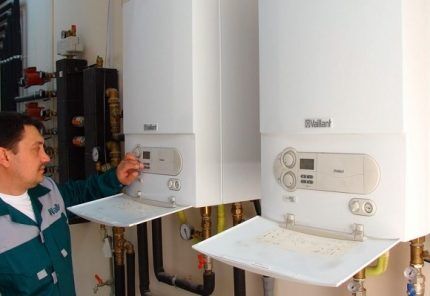
The second part of the encoded information about equipment errors is available only to gas workers, with whom the owner of the equipment must enter into a contract even before installing the unit. According to the contractual documentation, fuel is supplied, technical condition is monitored and repairs are performed.
To gain access to the second part of the error data, the gas service master enters a password that is unknown to the owner. It would seem that the owner does not need information about these errors at all, since all operations behind this “barrier” are still inaccessible to him.
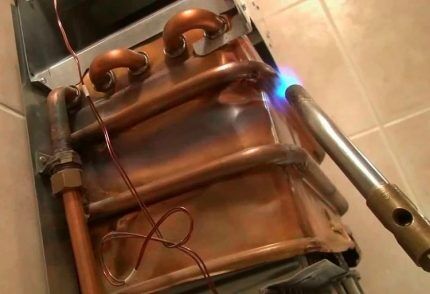
But! Let's remember how much money we invested in organizing heating. Let's think that a substantial amount was paid for the purchase, connection, and installation.And we will make sure that all work to restore the functioning of the unit is carried out in accordance with the manufacturer’s instructions. Therefore, we will find out what should be done when an error code appears on the display.
How to monitor the condition of the equipment?
In order to obtain information about an impending or already occurring malfunction, you need to use diagnostic programs designated by the company’s programmers in the menu in the range from P.0 to P.6.
Login to the information system is carried out as follows:
- We find two buttons on the control panel. One of them should have an “i” icon, the second a “+”.
- We activate both buttons at the same time. We hold them until “d.0” appears on the screen.
- Using the buttons with the “+” and “-” signs, we move forward in the list of faults to reach the point we need in the diagnosis. We confirm what we found by pressing the “i” button and get acquainted with the information provided by the system.
Note that entering even the first level diagnostic mode allows you to change settings. It happens that a double-circuit boiler is blocked, for example, due to too high a temperature set during setup before the first start. In solving such problems, it is not necessary to resort to the help of a specialist.
Operating parameters are changed by manipulating the “+” and “-” buttons already known to us. All changes made should be confirmed. New data is recorded by pressing the button with the “i” icon and then holding it down for a minimum of 5 seconds.
If the information provided by the boiler and the actions described in the manufacturer’s manual do not lead to the desired result, call a technician. He enters the password, which opens the next level of diagnostics.A certified repairman can see all the information about errors in the operation of the Vailant gas boiler and all the codes assigned by the manufacturer.
In addition to errors at both levels, the high-tech system can notify you about the technical condition of the unit. There is also division in this area. Status data is encoded with an alphanumeric combination starting with the letter “S”, error information begins with “F”.
List of first level problems
Let’s first consider what the owner can “fight” on his own, without fear of the product becoming completely unsuitable and voiding the warranty.
The list of situations available for correction includes two options:
- The boiler doesn't work at all. Those. the device does not heat the coolant if it is a single-circuit model, and does not heat either the coolant or sanitary water if it is a double-circuit model.
- The boiler heats sanitary water, but does not heat the coolant. This problem is typical only for dual-circuit units.
Both of these positions have a number of completely removable reasons and several solutions that a prudent owner should familiarize himself with. However, before a detailed study of the situation, you should check whether the boiler is connected to the network at all and whether one of the functions is disabled: heating or DHW.
Now let’s look at the typical causes and methods for eliminating them in the case when the boiler does not heat at all:
- The gas valve is closed. Both shut-off devices installed by gas workers on the inlet gas pipe must be opened.
- The supply of cold water is cut off. This can be solved by opening the shut-off valve on the water pipe.
- Power supply disruptions. The heating unit will stop operating if there is no power supply. If the electricity supply is restored, the boiler will start itself.
- Temperature set too low. The owner of the boiler corrects an oversight made when making settings by simply switching the unit to the required temperature regime.
- Water pressure drop (F22). The encoding will indicate a lack of pressure in the system for normal operation of the boiler. Its appearance means that you need to bleed the air from the batteries and open the make-up valve located at the bottom of the device.
- Refusal to ignite (F28). If the third attempt to ignite the gas heating equipment does not lead to the desired result, you need to find the fault reset button on the control panel, press it and hold the position for at least a second. Failure again? Call the gas workers.
- Chimney fault (F48). This signal indicates an increase in the temperature of the exhaust flue gases.They could have stagnated and overheated due to a clogged external chimney that needs to be cleaned.
Note that a drop in pressure will also be signaled by the S76 indicator. This code is from the boiler condition monitoring group. However, to restore operation, the same actions will be required as when fixing error F22.
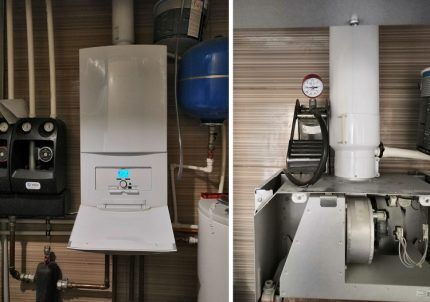
The second type of violation, determined by the operation of only DHW without heating coolant, most often associated with wizard errors made during settings. You can change the temperature yourself. The manual supplied with the boiler describes in detail how to perform this operation.
List of second level errors
Now let’s look at problems that only a service technician can decipher. Monitoring the actions of the performer, if you value a very expensive unit, can also be extremely useful. Especially if the repairman does not inspire proper confidence at first glance.
Let’s immediately make a reservation that if a dash is displayed on the display, then there are no violations in the functionality; most likely, the incorrect settings are disturbing. If several codes are displayed, alternating with each other, then there are several violations. This means that the technician will also have to choose the correct sequence for troubleshooting.
Error F.0. Problems with the NTC temperature sensor located on the supply branch. There are several reasons why the device has stopped recording the temperature. The sensor itself could fail, or the electrical connection could be broken.

In all cases, the boiler is disassembled to identify violations. If a loose connection to the electronic board is detected, it is restored. If a device or wire needs to be replaced, it will be done.
Error F.1. Problems with the NTC temperature sensor installed on the return pipe. All actions taken to eliminate the previous error are performed in the same order.
Error F.5. Failure of the flue gas sensor outside the boiler to operate. By analogy with previous errors, you need to check the plug connection to the electronic board and check the wiring. If the cause is not discovered, the sensor will have to be replaced.
Error F.6. Opening of the flue gas sensor within the boiler. They also check the cable, cable connections, plug connection to the electronic board and the device itself. Based on the results of identified breakdowns, contacts are restored, the wire or the recording device itself is changed.
Errors F.10; F.11; F.15; F.16. Short circuit: errors 10 and 11 - short circuit of the temperature sensors on the supply and return, codes 15 and 16 - short circuit of the flue gas sensors outside and inside. When a short circuit of all listed types of sensors is registered, they are replaced.
Error F.20. The temperature fuse has tripped. It is necessary to check whether the temperature sensor on the coolant supply branch is installed and connected correctly. Most often, the fuse trips for no real reason if the assembly of this section of the circuit was carried out incorrectly.Less often this happens due to a sensor failure.
Error F.22. The boiler is running dry or there is a lack of water in the unit. This is a signal that there is a leak in the device or the pump cannot cope with pumping. However, if no leak is detected, then the whole problem is in the pump: either it itself is broken, or the electrical connection is damaged. The problem is solved by replacement.
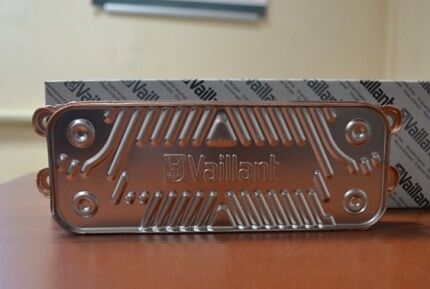
In addition, the device that blocks the operation of the boiler when the temperature limit is exceeded could break down. There is no point in repairing it; as a rule, this type of switch is replaced.
Error F.23. The readings taken by temperature sensors at the inlet and outlet of the boiler vary greatly. This most often occurs due to insufficient water volume in the unit or its movement is too slow. The pump is to blame - it is either broken or blocked.
Error F.26. The fuel flow supplied by the gas valve of the stepper device is not detected. In this case, the problem must be looked for in the wiring of the gas valve or in the electrical circuit used to connect it. There may be no contact between the stepper motor and the electronic board.
Error F.28. It is impossible to light the boiler; even after numerous attempts, the unit does not start. The most common causes of the problem include disturbances in the gas supply system to the combustion chamber. You need to check the gas valve; it is possible that it is simply set incorrectly and not broken.
The company that supplies gas to the consumer in accordance with the concluded agreement can fail. Blue fuel may contain too much air, the proportion of which exceeds the norm required for combustion. It is possible that the fire protection was activated.
If everything is in order with the gas supply system, problems should be looked for in the gas supply fittings. You need to check the solenoid valve, the ignition device, including its plug, the transformer, the wiring used in the connection and its terminals. Having ensured that the listed devices are operational, we begin testing the ionization cable and control board.

Error F.29. The flame went out while heating the coolant, after which the unit did not ignite at all. In this case, the fuel supply is interrupted by the ignition transformer. It needs to be checked, the ignition device cleaned or replaced. Also worth checking boiler grounding: whether it is arranged and how correctly everything was done.
Error F.36. The boiler operation is blocked by the exhaust gas sensor. First of all, you need to check the smoke exhaust duct; if necessary, it must be restored or cleaned. If there was no blockage or severe narrowing in the channel due to burning build-up, it means that the sensor itself or the line connecting it to the electrical circuit is faulty.
Error F.49. Voltage drop on the electronic bus. This is the result of a short circuit on the bus or connecting two sources of opposite polarity to it.
Error F.61. Gas valve control problems. Occurs due to a short circuit in the electromagnetic part of the gas valve or due to a short circuit to the cable insulation. Another reason is a malfunction of the electronic control device.
Error F.62. Changing the gas valve activation delay. Consequently, the tightness of the fittings supplying gas and regulating its pressure is broken.
Error F.63; F.64. Damage to the electronic board or sensors connected to it. It is necessary to check the sensors, the electrical wiring connecting them to the board, and the electronic board itself.
Error F.65. Heating of electronics. The temperature of the electronic control device is too high due to the proximity of heating devices or due to failure of the electronic board. The distance specified in the appliance manual must be maintained between the electronic control system and any equipment that generates heat during use.

Error F.67. The ionization device does not work. Traditionally, the device itself, the electronic board and the electrical circuit connecting them are checked.
Error F.70. The electronic board and/or display display does not display all functions or does not display them at all. Solved by replacing the unsuitable option.
Error F.71; F.72. The supply and return line sensor readings are incorrect.Sensors, electronic board, wiring and electrical connections should be checked.
Error F.73. Demonstration of incorrect data by the pressure sensor. The pressure sensor itself is broken or the electrical circuit between the board and the device that records the pressure values in the system is broken.
Error F.75. Lack of response of the pressure sensor to pressure fluctuations. If the sensor does not react in any way to a sharp increase and decrease in water pressure, it means that it is faulty and will have to be replaced. The truth is that the reason is not in it, but in the circulation pump, then you will have to change the pump.
Error F.77. Damage to the exhaust gas damper. There is a slight smoke sensation in the room with the boiler. You should immediately arrange a burst of ventilation and call a technician to check the device and carry out repairs.
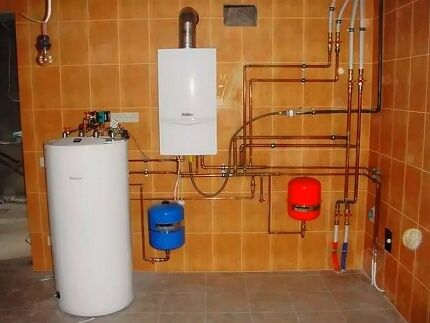
We considered only disturbances in the operation of atmospheric boilers. The lists of errors of traditional turbocharged and condensate models are somewhat different, which is justified by the difference in design solutions and differences in operating principles. A complete list can be found in the instructions for manufacturer-certified gas fitters accredited to carry out repairs.
An important advantage: all models of Vailant boilers are equipped with a so-called “error accumulator”. It displays ten extreme operational violations recorded by the boiler electronics. You can find this position in the board menu by simultaneously pressing two buttons “i” and “-”.
If, after reading the information about violations, you do not press any of the keys for 4 seconds, the boiler electronics will automatically return it to the previous operating mode.
Conclusions and useful video on the topic
A video with an analysis of how to fix error F.75 and a visual representation of the components of the unit:
Video guide for repairing the boiler control system board:
Valuable recommendations from an experienced owner on switching the boiler to work in accordance with the season:
In order to be less likely to encounter equipment breakdowns, you must strictly follow the manufacturer’s instructions, which are thoroughly spelled out in the manual attached to the product. Compliance with operating instructions is a guarantee of uninterrupted operation. But if a violation occurs, our tips will help you quickly find the cause.
Would you like to share your own experience in restoring the functionality of a heating system with a Vaillant boiler or a similar unit? Do you know the technological subtleties of repair that are worth sharing with site visitors? Share useful information and photos on the topic of the article in the comment block below.



